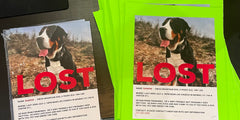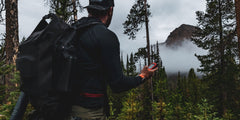
Landing back in Salt Lake City on July 3, the plane touched down and my phone exploded with messages.
“Call me ASAP.”
My friend had let my Swiss Mountain Dog, Barron, out to relieve himself before turning in for the night, and a nearby neighbor decided to shoot off a firework.
“He just ran. I couldn’t catch him.” My panicked friend said.
“It’s ok, we’ll find him.” Barron had never run away, and while he could be skittish from time to time, I’d always been able to locate him no matter the situation - and we’d had plenty of situations together.
Given it was 11pm, I raced home to my house, grabbed my e-bike and my thermal scope (which helps find heat signatures, day or night) and headed to find my dog.
“The last I saw, he was running through here.” My friend pointed down a now dark, one-lane road, leading from a group of apartment buildings, through a small golf course, and in to the small town of Midway, UT.
I assumed he’d just be on the golf course. Nervous to return to where the firework went off. I just had to find him and he’d trot up. We’d be headed home in no time. But as the miles and hours stacked up, I began to worry. I started picking up the pace, yelling louder, and frankly, began to freak out. This was a real problem.
Over the next 4 days, I searched day and night alongside an army of friends and strangers who gave up their holidays, evenings and mornings to help me find my buddy. In the heat of the day, when I assumed he’d be hiding in the shade, I researched how to find a lost dog, and called and spoke with several experts from around the country.
What I learned was shocking: What instinctually feels right, is often the opposite of what you should do when searching for a dog. I was fortunate to quickly find the right information, and without it, this story would likely have had a very different, and tragic ending.
Barron showed up 4 days later, on a golf course. I received half a dozen calls in seconds - people had seen the flyers, and he had finally come out of hiding. Just like the experts predicted.
In an effort to help educate and hopefully prevent others from making the same mistakes, here are the most important things I learned that will help if you’re in a similar situation.
GET THE WORD OUT. BUT DON’T YELL.
Time is of the essence, but what you should do first is counter intuitive. My instinct was to run up and down the streets, yelling for Barron. Given he was already frightened, and I had no idea of his location, I wasted too much time on an ineffective tactic.
Instead, get the word out as far and wide as possible. Make posters (bigger than 8.5 x 11, and neon in color) and make concentric circles away from where your dog was last seen out to 2 miles. As days go on, add a mile for every day or two they are missing. Social media is great, but I learned that almost every dog is found because a stranger saw a sign, and then saw the dog. You are not looking for your dog. You are looking for someone who has seen your dog.
Call local police, fire, humane society, and animal shelters and make sure they are aware of your dog. It got to a point that when I’d call, they’d say “Is this Christian? No… we haven’t seen Barron”. They may have been annoyed, but I was confident they weren’t going to forget us if he came in.
BE PATIENT
This doesn’t mean do nothing. Hand out flyers, put up posters, talk to people in the neighborhood. We talked to everyone we crossed paths with, and especially to people out walking their dogs. Barron loves other dogs, and my guess was that he would approach another dog before he would approach a strange human. That said, it takes time to build an army of people looking, and then have one of them cross paths with your dog. I heard over and over that it often takes several days for a dog to calm down, get hungry, and come out of hiding. Make sure when that time comes, people are aware of the situation.
TRACKING AND TRAPPING
There are professional dog/cat finders out there. Do a google search and start to talk to them right away. Whether you hire them or not, they are likely familiar with the area and know patterns to where dogs are often found. You’ll get great advice and it may even be worth ultimately hiring them. The trapper I had hired - though we didn’t need her in the end - told me she has a 95% success ratio. That’s incredibly impressive. And the scent dog I had on the way could follow a scent over 30 days old. That said, the sooner the better.
GET SMELLY
I slept in my truck near his last known location for 3 nights. He didn’t come back, but I heard that this often works, and given dogs can smell you for several weeks after you’ve been around, the longer you stay in one place, the more of an anchor it creates that can lure them in next time they cross paths. Don’t be afraid to leave clothes or a dog bed in a location they might visit - like their last known location, a frequented friends’ house, or a trailhead that you run often with your pet. If your dog has a super strong food drive, cook some bacon for a few hours and see if it draws them in. You’d be surprised how effective this is.
MAGNET/NOSE
I learned some crazy stuff about dogs. Did you know they always face a certain way when pooping to align with the magnetic fields of the Earth? They have an extremely strong magnetic pull to familiar locations - much like a homing pigeon. Add to it their ability to layer and catalog different scents to create a map home, this is how you get real-life Homeward Bound stories.
I received dozens of messages from people whose dogs, after a week or two, suddenly showed up at home, even when lost dozens or hundreds of miles away. My dog didn’t leave a very small radius, but I certainly can see a working dog type, who is always eager to solve a problem, start to figure out its way home. If this is the case, make sure you have a place for them to go in to, or a dog bed outside that will keep them there in the event you’re not home.
ANCHOR DOGS
A dog’s dog-friend is a powerful asset. Finn is a co-worker’s dog, and is at the office with Barron every day, not to mention Barron often stays with Finn and Kate when I’m traveling. The day before we found Barron, Finn pulled Kate to a random yard and didn’t want to leave. His nose was ‘going crazy’ according to Kate, and she couldn’t figure out why. In the end, we found him just a few hundred yards from this location. Finn knew Barron was close, and likely given enough time, they would have found each other.
DON’T GIVE UP
Dogs are incredible survivors. Dogs quickly revert to survival mode when lost. It is as if a switch gets switched in their head, and even the most domesticated pet becomes ‘feral’. It’s also why you may spot your dog, but they run when you call. When a dog will switch into this mode varies greatly - it can happen in an instant or over several days. Much of it depends on a depletion of serotonin. Serotonin is responsible for several functions, including short term memory. It is also rapidly depleted in stressful situations. If a dog is stressed, this creates short term memory loss and pushes them in to survival mode, which can literally make them behave as if they don’t want to be found. They will likely look for a safe place to live and find water and food to survive. Once they have these, and can relax for a day or two, they potentially will start thinking again and find their way back.
WILD ANIMALS AREN’T REALLY A PROBLEM
Despite being surrounded by national forest filled with mountain lions, black bears and coyotes, the professionals I spoke with all said the same thing - they never really see wild animals killing lost dogs.
THINK ABOUT YOUR DOG
I found Barron on a golf course around 7:30am. We run through a different golf course around 6:30 am each morning. I can only assume the smells, sights and even the grass created a familiar environment for him. I’m not saying this is science, but it personally makes a lot of sense to me that a dog would seek familiarity when in an unknown environment.
I was blown away by the help I received from friends, family and strangers. The love between a dog and his human is one that most understand, and because of that, most people want to help. Don’t be afraid to ask for help. Get the word out, trust the process and the odds will be in your favor.




